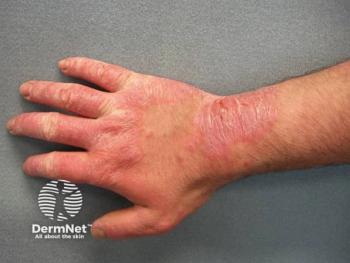
New Trial Explores AD Treatment in Patients Under 2

Key Takeaways
- Atopic dermatitis affects 1 in 5 children, with infants experiencing the highest incidence, causing significant discomfort and stress.
- Roflumilast cream 0.05%, a PDE4 inhibitor, has shown efficacy in older patients and is being evaluated for infants with AD.
Explore the INTEGUMENT-INFANT study, assessing roflumilast cream's safety and efficacy for infants with atopic dermatitis in a groundbreaking trial.
Atopic dermatitis (AD) is estimated to impact 1 in 5 children worldwide, with its highest incidence observed in infants between 3 and 6 months of age. The disease is characterized by intense pruritus, eczematous lesions, and often a relapsing-remitting course, leading to substantial discomfort for patients and considerable stress for their families. Current therapeutic strategies primarily involve topical corticosteroids (TCS), topical calcineurin inhibitors (TCIs), and phosphodiesterase 4 (PDE4) inhibitors. While these treatments offer relief, there remains a critical unmet need for safe and effective options specifically tailored for the youngest patients.1
Roflumilast cream 0.05%, a highly potent and selective PDE4 inhibitor, has demonstrated efficacy and safety in adults and adolescents aged 12 years and older with AD. PDE4 inhibitors work by increasing intracellular cyclic adenosine monophosphate (cAMP) levels, thereby reducing inflammation. Given its established profile in older age groups, the potential for roflumilast cream to address the therapeutic gap in infant AD is of considerable interest. A poster presented at the
Study Design and Methodology
The INTEGUMENT-INFANT study is structured as a 4-week, open-label, single-arm trial. This design allows for a focused assessment of the investigational product in a specific, vulnerable population without the complexities of blinding or a control arm in this initial phase. The primary objective is to evaluate the safety and tolerability profile of roflumilast cream 0.05% when administered once daily (QD) for 4 weeks. Secondary objectives include the assessment of various exploratory efficacy outcomes.
Participants will be infants aged 3 to 24 months with a clinical diagnosis of AD for at least 6 months prior to screening. Crucially, eligible infants must present with an Investigator’s Global Assessment (IGA) score of 2 (mild) or 3 (moderate) at baseline, indicating their disease severity. Furthermore, the body surface area (BSA) affected by AD must be between 5% and 20% at baseline.
Endpoints and Assessments
The primary endpoint of the INTEGUMENT-INFANT study focuses on safety and tolerability. This will be comprehensively assessed through the monitoring of adverse events (AEs), changes in vital signs, and laboratory abnormalities throughout the 4-week treatment period. Physical examinations will also be conducted at each visit to further evaluate the safety profile.
In addition to safety, several exploratory efficacy endpoints will be evaluated at week 4 to gain preliminary insights into the potential therapeutic benefits of roflumilast cream in this population. These include:
- IGA Success: Defined as an IGA score of 0 (clear) or 1 (almost clear), reflecting a significant improvement in overall disease severity.
- Percent Change from Baseline in Eczema Area and Severity Index (EASI): The EASI score is a widely used objective measure of AD severity, assessing the extent and intensity of erythema, induration/papulation, excoriation, and lichenification.
- Percent Change from Baseline in Worst Itch-Numeric Rating Scale (WI-NRS): For subjects aged 6 months and older, the WI-NRS will quantify the reduction in the most bothersome symptom of AD.
- Percent Change from Baseline in Patient-Oriented Eczema Measure (POEM): This patient-reported outcome measure assesses the impact of AD on daily life.
- Percent Change from Baseline in Dermatology Life Quality Index (DLQI): For subjects aged 6 months and older, the DLQI evaluates the impact of skin disease on a patient's quality of life.
- Sleep Disturbance: Assessment of improvements in sleep patterns, a common issue for infants with AD.
- Caregiver Global Assessment (CGA): A caregiver-reported measure of the infant’s overall AD severity.
Patient Participation and Study Sites
The study plans to enroll approximately 100 patients across 20 to 30 clinical sites located in the United States, Canada, and Australia. Patient participation will involve 4 scheduled visits: Screening, baseline, week 2, and week 4. These visits will facilitate the collection of safety data, clinical assessments, and caregiver-reported outcomes.
Conclusion
The INTEGUMENT-INFANT study represents a crucial step in evaluating roflumilast cream 0.05% as a potential treatment option for infants with mild to moderate atopic dermatitis. By thoroughly assessing its safety and tolerability profile, alongside exploratory efficacy measures, the study aims to provide valuable data on the utility of this PDE4 inhibitor in a population with limited targeted therapeutic choices. The findings from this phase 2 study are anticipated to provide important information that could pave the way for further development and potentially offer a much-needed new treatment for this vulnerable patient group.
References
- Jin L, Ge J, Cheng Y, Deng D, Wan P. Worldwide prevalence of atopic dermatitis in children between 2000 and 2021: A systematic analysis. Ann Allergy Asthma Immunol. 2025;134(5):603-609.e6. doi:10.1016/j.anai.2024.12.005
- Hebert A, Eichenfield L, Gonzalez M, et al. INTEGUMENT-INFANT: 4-week open-label safety of roflumilast cream 0.05% in 3-24-month-olds with atopic dermatitis. Poster presented at: The Society for Pediatric Dermatology Meeting 2025. July 23-26, 2025. Seattle, Washington.
Newsletter
Like what you’re reading? Subscribe to Dermatology Times for weekly updates on therapies, innovations, and real-world practice tips.



















